engine BUICK SKYLARK 1993 Owner's Guide
[x] Cancel search | Manufacturer: BUICK, Model Year: 1993, Model line: SKYLARK, Model: BUICK SKYLARK 1993Pages: 306, PDF Size: 15.84 MB
Page 172 of 306
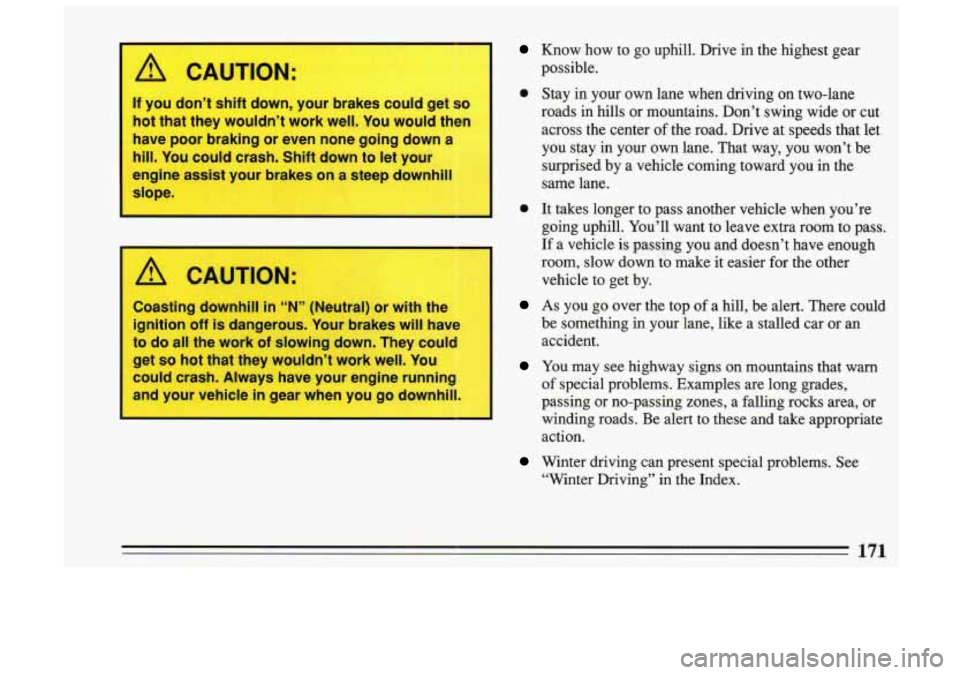
1 CAUTION:
If you don’t shift down, your brakes COL., get so
hot that they wouldn’t work well. You would then
have poor braking or even none going down a
3‘
hill. You could crash. Shift down to let your
engine assist your brakes on a steep downhi
Know.how to go uphill. Drive in the highest gear
possible.
slope.
I.
A CAUTION:
Coasting downhill in “N” (Neutr; or with the
ignition off is dangerous. Your brakes will have
to do all the work of slowing down. They cou
get
so hot that they wouldn’t work well. You
could crash. Always have your engine running
and your vehicle
in gear when you go downh
Stay in your own lane when driving on two-lane
roads in hills or mountains. Don’t swing wide or cut
across the center
of the road. Drive at speeds that let
you stay in your own lane. That way, you won’t be surprised by a vehicle coming toward you in the
same lane.
It takes longer to pass another vehicle when you’re
going uphill. You’ll want to leave extra room to pass.
If a vehicle is passing you and doesn’t have enough
room, slow down to make it easier €or the other
vehicle to get by.
..
1
I As you go over the top of a hill, be alert. There could
be something in your lane, like a stalled car or an
accident.
of special problems. Examples are long grades,
I
passing or no-passing zones, a falling rocks area, or 1
winding roads. Be alert to these and take appropriate
action.
I You may see highway signs on mountains that warn
Winter driving can present special problems. See
“Winter Driving” in the Index.
171
Page 176 of 306
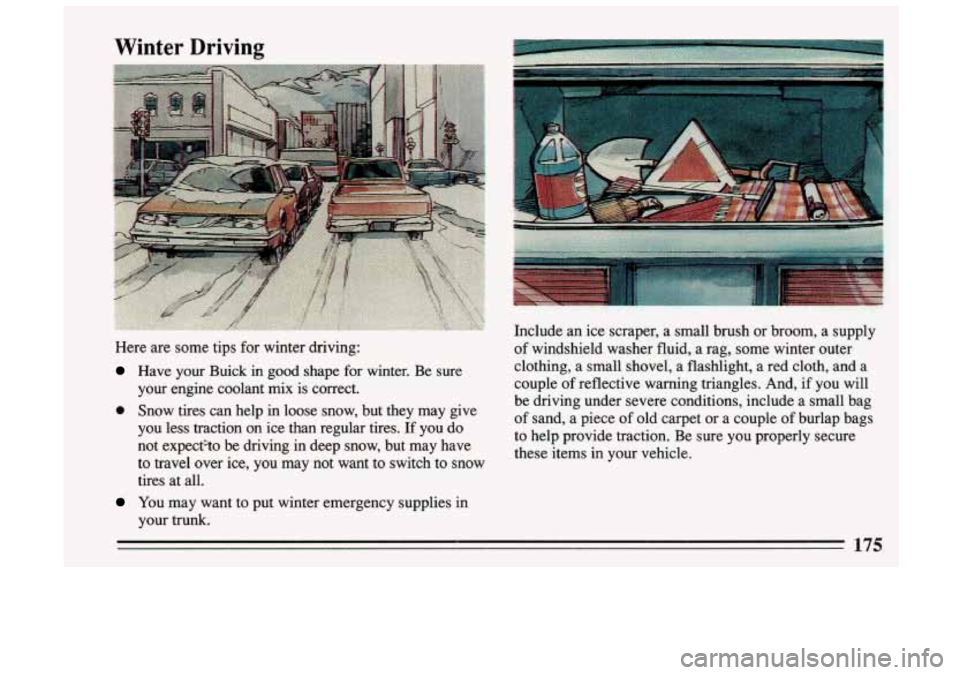
Winter Driving
Here are some tips for winter driving:
Have your Buick in good shape for winter. Be sure
your engine coolant mix is correct.
e Snow tires can help in loose snow, but they may give
you less traction on ice than regular tires. If you do
not expect30 be driving
in deep snow, but may have
to travel over ice, you may not want to switch to snow
tires at all.
YOU may want to put winter emergincy supplies in
your trunk. Include
an ice
scraper, a small brush or broom, a supply
of windshield washer fluid, a rag, some winter outer
clothing,
a small shovel, a flashlight, a red cloth, and a
couple of reflective warning triangles. And, if you will
be driving under severe conditions, include a small bag
of sand, a piece
of old carpet or a couple of burlap bags
to help provide traction.
Be sure you properly secure
these items in your vehicle.
175
Page 178 of 306
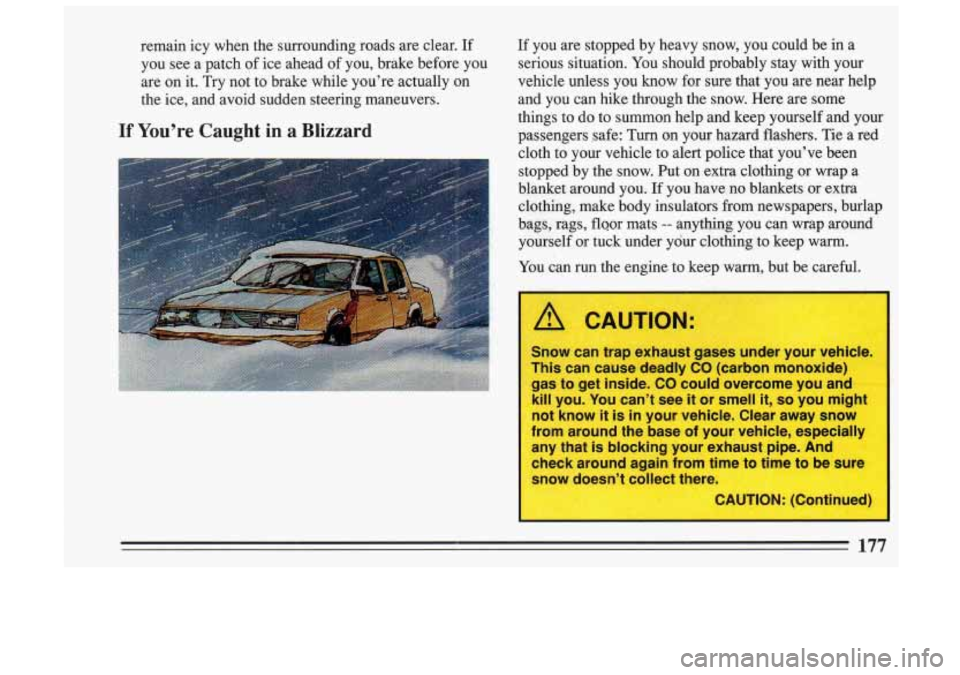
remain icy when the surrounding roads are clear. If
you see a patch of ice ahead of you, brake before you
are on it. Try not to brake while you’re actually on
the ice, and avoid sudden steering maneuvers.
If You’re Caught in a Blizzard
If you are stopped by heavy snow, you could be in a
serious situation. You should probably stay with your
vehicle unless you know for sure that you are near help
and you can hike through the snow. Here are some
things to do to summon help and keep yourself and your
passengers .safe: Turn on your hazard flashers. Tie a red cloth to your vehicle to alert police that you’ve been
stopped by the snow. Put on extra clothing
or wrap a
blanket around you.
If you have no blankets or extra
clothing, make body insulators from newspapers, burlap
bags, rags, flsor mats
-- anything you can wrap around
yourself
or tuck under your clothing to keep warm. I
You can run the engine to keep warm, but be careful.
I
A CAUTION:
dnow can trap exhaust gases under your vehicle
This can cause deadly
CO (carbon monoxide)
gas to get inside. CO could overcome you and
kill you. You can’t see
it or smell it, so you might
not know
it is in your vehicle. Clear away snow
from around the base of your vehicle, especia”--
any that
is blocking your exhaust pipe. And
check around again from time to time to be’su
snow doesn’t collect there.
177
Page 180 of 306
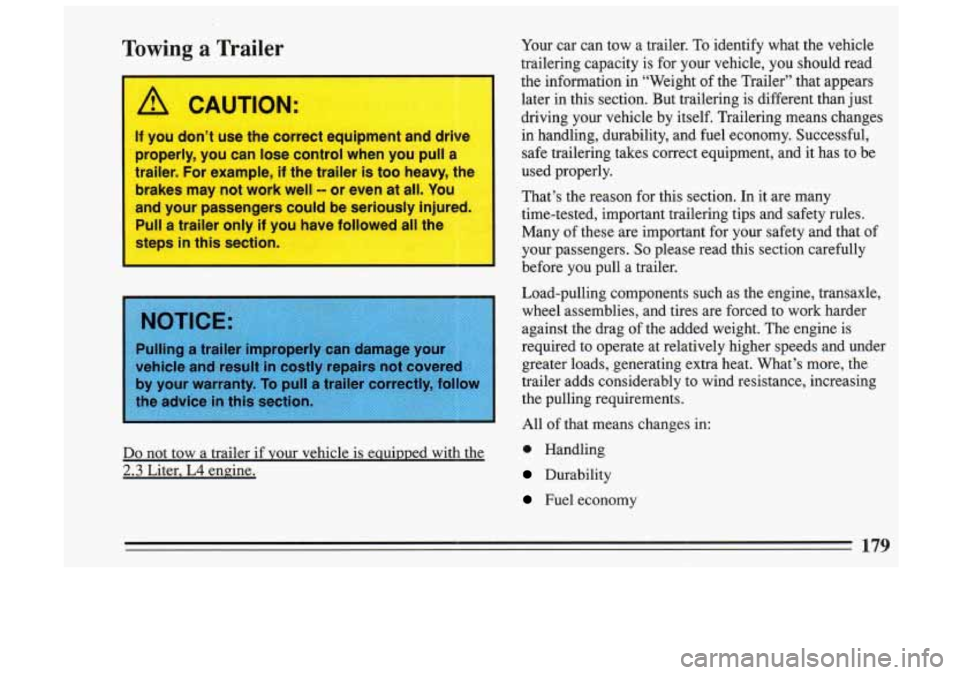
Towing a Trailer
A CAUTION:
If you don’t use the correct equipment and drive
properly, you can lose control when you pull
a
trailer. For example, if the trailer is too heavy. the
brakes may not work well
-- or even at all. Yo
and your passengers could be seriously injured.
Pull
a trailer only if you have followed all the
steps in this section.
i ~ ~, ~~ ~~
~~~ ~~ before you pull a trailer.
Your
car can tow a trailer.
To identify what the vehicle
trailering capacity is for your vehicle, you should read
the information in “Weight of the Trailer”. that appears
I later in this section. But trailering is different than just
driving your vehicle by itself. Trailering means changes
I in. handling, durability, and fuel economy. Successful,
safe trailering takes correct equipment, and it has to be
I used properly.
That’s the reason for this section. In it are many
time-tested, important trailering tips and safety rules. Many of these are important for your safety and that of
I your passengers. So please read this section carefully
Load-pulling components such as the engine, transaxle, wheel assemblies, and tires are forced to work harder
against the drag of the added weight. The engine is
greater loads, generating extra heat. What’s more, the
trailer adds considerably to wind resistance, increasing
the pulling requirements.
All of that means changes in:
ulling a trailer improper1 required to operate at relatively higher speeds and under
Do not tow a trailer if your vehicle is equipped with the
0 Handling
2.3 Liter, L4 engine. Durability
Fuel economy
179
Page 181 of 306
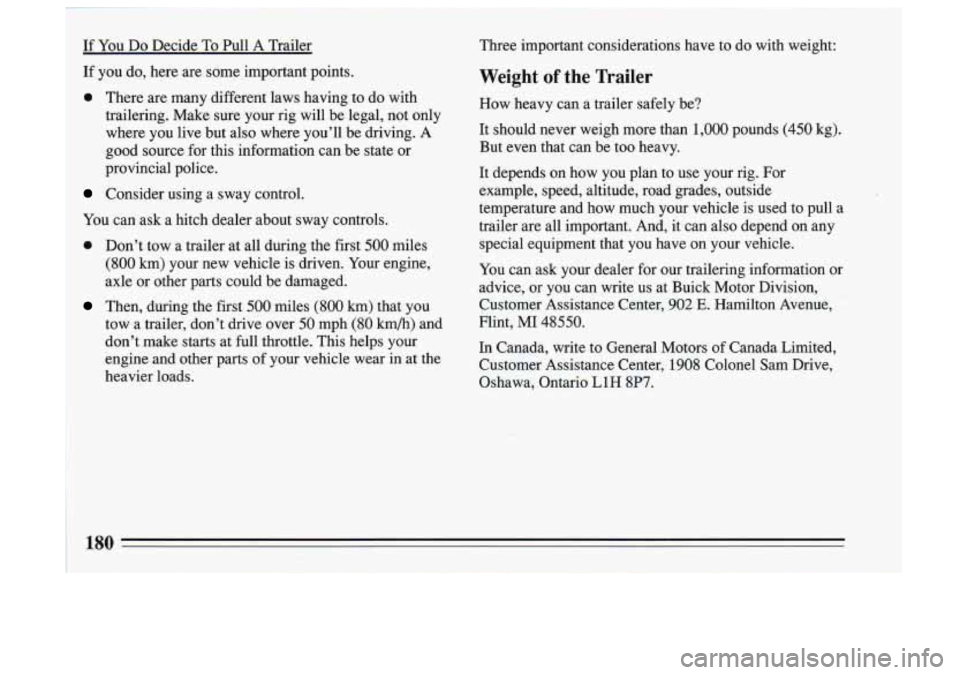
If You Do Decide To Pull A Trailer Three important considerations have to do with weight:
If you do, here are some important points.
Weight of the Trailer
0 There are many diflerent laws having to do with
How heavy can a trailer safely be?
trailering. Make sure your rig will be legal, not only
where you live but also where you’ll be driving. A It shou\
ld never weigh more than
1,000 pounds (450 kg).
good source for this information can be state or But even that can be too heavy.
provincial police. It depends on how you plan to use your
rig. For I
1 Consider using a sway control. example, speed, altitude, road g\
rades, outside
temperature and how much your vehicle is used
to pull a
trailer are all important. And, it can also depend on any
You can ask your dealer for our trailering information or
You
can ask a hitch dealer about sway controls.
0 Don’t tow a trailer at all during the first 500 miles special equipment that you have on your vehicle.
(800 km) your new vehicle is driven. Your engine,
axle or other parts could be damaged. advice, or you can write us \
at Buick Motor Division,
Then, during the first 500 miles (800 km) that you Customer Assistance Center, 902 E. Hamilton Avenue,
tow a trailer, don’t drive over
50 mph (80 h/h) and Hint, MI 48550.
don’t make starts at full throttle. This helps your
In Canada, write to General Motors of Canada Limited,
heavier loads. Oshawa, Ontario L1H
8P7.
en€!ine and other Paas Of Your wear in at the Customer Assistance Center, 1908 Colonel Sam Drive,
.I
Page 184 of 306
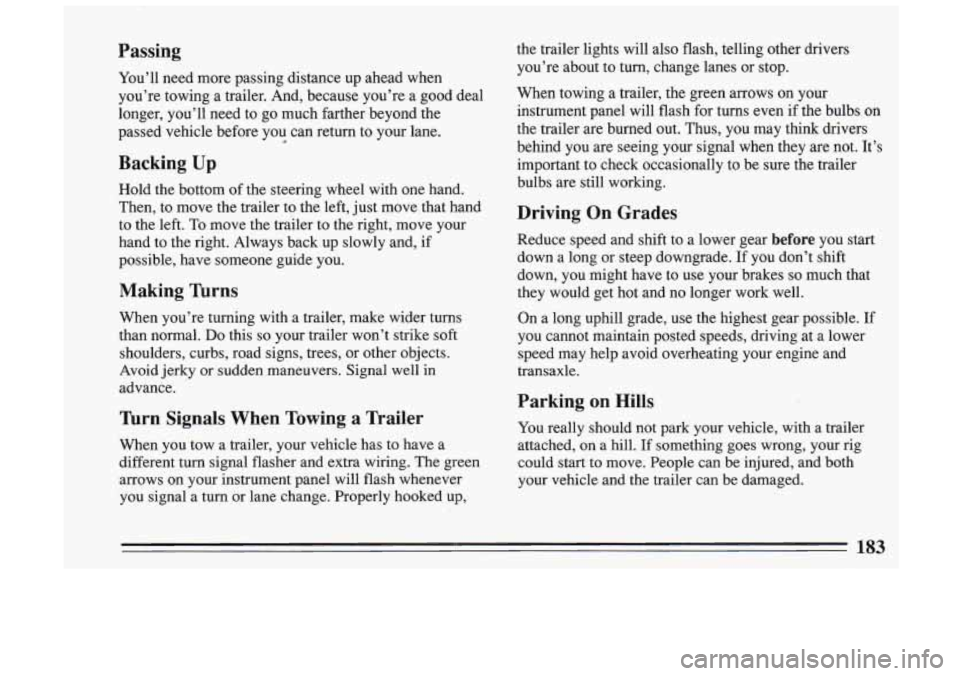
Passing
You’ll need more passing distance up ahead when
you’re towing a trailer. And, because you’re a good deal \
longer, you’ll need to go much farther beyond the
passed vehicle before you can return to your lane.
d
Backing Up
Hold the bottom of the steering wheel with one hand.
Then, to move the trailer to the left, just move that hand
to the left. To move the trailer to the right, move your
hand to the right. Always. back up slowly and, if
possible, have someone guide you.
Making Turns
When you’re turning with a trailer, make wider turns
than normal.
Do this so your trailer won’t strike soft
shoulders, curbs, road signs, trees, or other objects.
Avoid jerky or sudden maneuvers. Signal well in
advance.
nrn Signals When Towing a Trailer
When you tow a trailer, your vehicle has to have a
different turn signal flasher and extra wiring. The green
arrows on your instrument panel will flash whenever you signal a turn or lane change. Properly hooked up, the trailer lights will also flash, telling other drivers
you’re about to turn, change lanes or stop.
When towing a trailer, the green arrows on your
instrument panel will flash for turns even if the bulbs on
the trailer are burned out. Thus, you may think drivers
behind you are seeing your signal when they are not. It’s
important to check occasionally to be sure the trailer
bulbs are still working.
Driving On Grades
Reduce speed and shift to a lower gear before you start
down a long
or steep downgrade. If you don’t shift
down, you might have to use your’brakes
so much that
they would get hot and no longer work well.
On a long uphill grade, use the highest gear. possible. If
you cannot maintain posted speeds, driving at a lower
speed may help avoid overheating your engine and
transaxle.
Parking on Hills
You really should not park your vehicle, with a trailer
attached, on a hill. If something goes wrong, your rig
could
start to move. People can be injured, and both
your vehicle and the trailer can be damaged.
183
Page 185 of 306
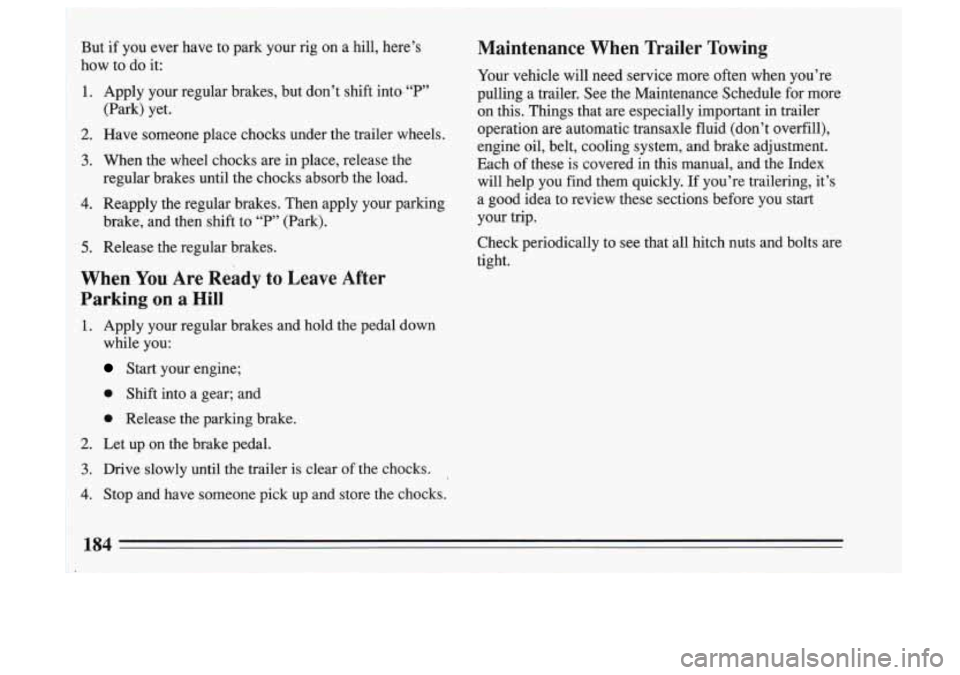
But if you ever have to park your rig on a hill, here’s
, how to do it:
1 1. Apply your regular brakes, but don’t shift into.“P”
I (Park) yet.
I 2. Have someone place chocks under.the trailer wheels.
1
I
I I
I 3. When the wheel chocks are in place, release the
regular brakes until the chocks absorb the load.
4. Reapply the regular brakes. Then apply your parking
brake, and then shift to
“F’” (Park).
5. Release the regular brakes.
,. I I
~ When You Are Ready to Leave After
I Parking on a Hill
Maintenance When Trailer Towing
Your vehicle will need service more often when you’re
pulling a trailer. See the Maintenance Schedule for more
on this. Things that are especially important in trailer
operation are automatic transaxle fluid (don’t overfill),
engine oil, belt, cooling system, and brake adjustment.
Each of these is covered in this manual, and the Index
will help you find them quickly.
If you’re trailering, it’s
a good idea to review these sections before
you start
your trip.
Check periodically to see that all hitch nuts and bolts are
tight.
I 1. Apply your regular brakes and hold the pedal down
while you:
Start your engine;
0 Shift into a gear; and
0 Release the parking brake.
2. Let up on the brake pedal.
3. Drive slowly until the trailer is clear of the chocks.
4. Stop and have someone pick up and store the chocks.
284
Page 186 of 306
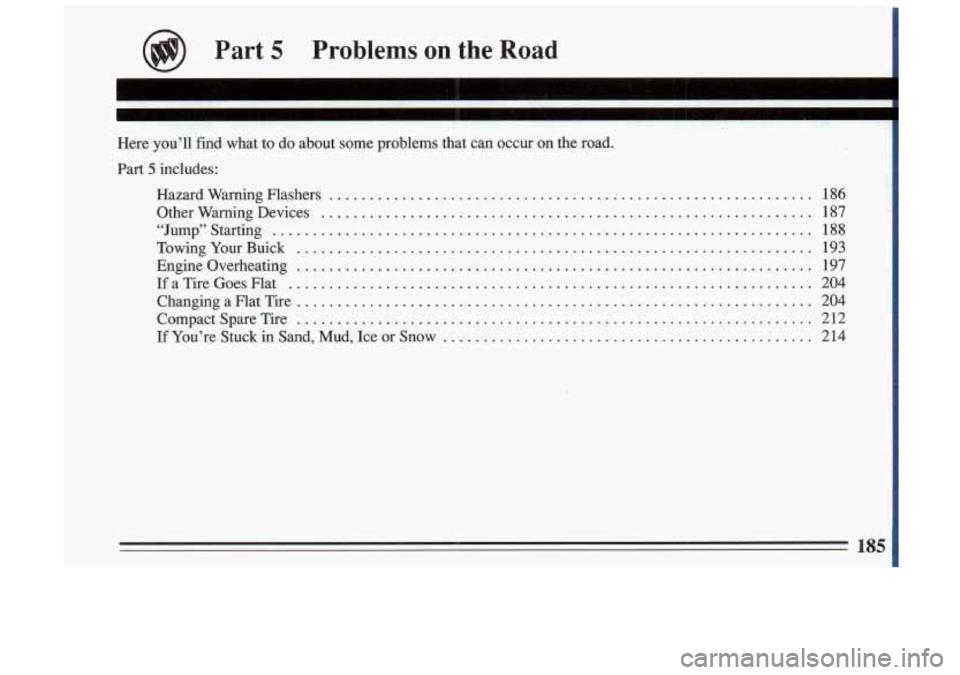
Part 5 Problems on the Road
I
Here you’ll find what to do about some problems that can occur on the road .
Part 5 includes:
Hazard Warning Flashers
............................................................ 186
OtherWarningDevices
............................................................. 187
“Jump”Starting
................................................................... 188
TowingYourBuick
................................................................ 193
Engineoverheating
................................................................ 197
IfaTireGoesFlat
................................................................. 204
ChangingaFlatTire
................................................................ 204
CompactSpareTire
................................................................ 212
If You’re Stuck in Sand, Mud, Ice or Snow
.............................................. 214
Page 191 of 306
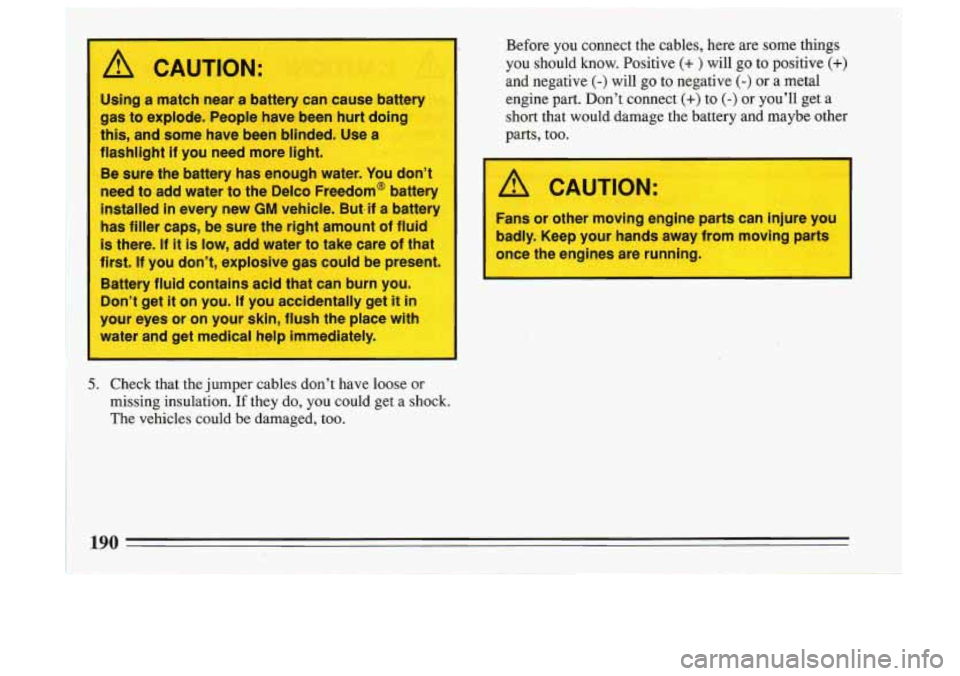
Before you connect the cables, here are some things
you should know. Positive (+ ) will go to positive (+)
and negative (-) will go to negative (-) or a metal
engine part. Don't connect
(+) to (-) or you'll get a
short that would damage the battery and maybe other
parts, too.
I
5. Check that the jumper cables don't have loose or
missing insulation. If they do, you could get a shock.
The vehicles could
be damaged, too.
190
r
Page 193 of 306
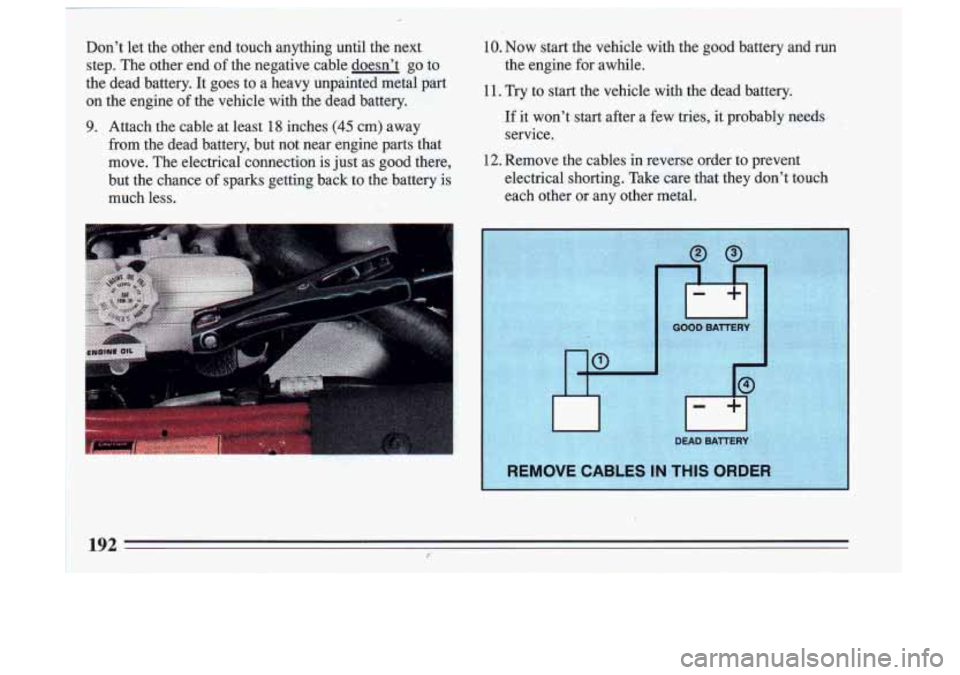
Don't let the other end touch anything until the next
step. The other end of the negative cable doesn't go to
the dead battery. It goes to a heavy unpainted metal part
on the engine of the vehicle with the dead battery.
9. Attach the cable at least 18 inches (45 cm) away
from the dead battery, but not near engine parts that
move. The electrical connection is just as good there,
but the chance
of sparks getting back to the battery is
much less.
10. Now start the vehicle with the good battery and run
the engine for awhile.
11. Try to start the vehicle with the dead battery.
If it won't start after a few tries, it probably needs
service.
'-? - ' * < :.!. , .,_. = , .::.t, ._ .. . . c_
12. Remove the cables in reverse order to prevent
electrical shorting. Take care that they don't touch each other or any other metal.